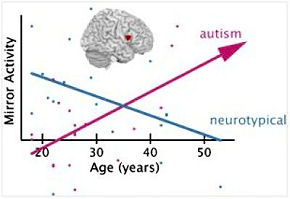4 May 2011
Mirror neuron development reversed in autistic brain
by Kate Melville

The brain's mirror neuron system enables us to better understand and anticipate the actions of others, leading researchers to posit that autism may come about because of a crippled mirror neuron architecture. But new research published in Biological Psychiatry shows that individuals with autism eventually develop a very robust mirror neuron network.
"While most of us have their strongest mirror activity while they are young, autistic individuals seem to have a weak mirror system in their youth, but their mirror activity increases with age, is normal by about age 30 and unusually high thereafter," explained Dr. Christian Keysers, the lead author on the project.
Keyser, from the Groningen University Medical Center, Netherlands, speculates that the increase in functionality of mirror neuron systems may be related to increased capacity for social function or responsiveness to rehabilitative treatments among individuals with autism.
The new finding of late developing mirror neuron functions could be very important and might help in identifying novel treatment mechanisms for autism. The researchers said that one of the next steps in this line of research will be to examine how individuals with autism accomplish this improvement over time, and how therapeutic interventions targeting the same mechanism can help to support this important process.
Related:
Autism may be reversible thanks to newly identified DNA "tag"
Autism risk tripled with IVF
Oxytocin Touted As Autism Treatment
Autism, Asperger's and Evolution
Source: Biological Psychiatry
